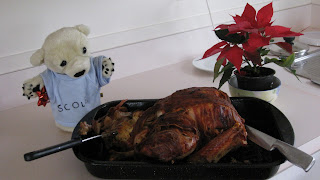 |
| Teaching at the village school |
 |
| The school bus |
Coral reefs
The reefs come right up to the shores of the islands so on with the mask and snorkel to see a fantastic underwater world. The colours are amazing, both fish and coral with shades from the whole spectrum that do not look real. The shapes of the coral are also varied, some smooth and rounded whilst others are spikey and sharp. There are soft corals, which move in water, and hard, rigid corals. All provide food and shelter for a huge variety of fish. We found Nemo! Among the corals are sea anemones where the clown fish, like Nemo, live. As large fish, like us, swim by they all dart back to the shelter of the anemone. Other types of fish use the coral as shelter. Damsel fish hide in coral of the same colour so blue damsel fish go to blue coral, green to green coral and so on. The reefs in Fiji can grow at a rate of 5 centimetres a year, the clear water around Fiji helps this as sunlight is essential to healthy coral growth.
Food
Traditional food consists of root vegetables and fruit with lagoon fish and pork.
The vegetables include taro, cassava, breadfruit and sweet potatoes. Pork is cooked in a ‘lovo’, this is a kind of underground oven. The pit is filled with coconut husks which are burned with coral rocks. The pig or fish is wrapped in banana leaves and the hot rocks are put around it then all buried in the sand for a few hours. The meat is delicious, very tender and succulent, with no washing up! Cassava is used like potato, we had chips, roast and mashed during our stay. Fijians used to be cannibals and sailors who were shipwrecked were liable to be killed and eaten as they were thought to be cursed and abandoned by the gods. Captain Bligh, set adrift after the ‘mutiny on the Bounty’, had his boat chased by cannibals as he passed the islands. The channel that he went through is still called the Bligh passage.
School visit
 |
| Cassava |
 |
| Is this Nemo grown up? |
 |
| Big blue starfish in the coral |
 |
| Blue damsel fish |
 |
| Why is this called a brain coral? |
There are no roads on the small islands so transport is by boat or footpaths. Each village has a kindergarten and most islands have primary schools. If the school is a long way from the village children from 6 years old sleep at the school during the week. The only secondary schools are in the 2 large islands so all children from the small islands board at school. We met some children going home from the mainland for their Christmas holiday by boat, different to the school bus! We visited the kindergarten in our local village and gave them some pens and note books as presents from Scole. They would really have preferred to keep Scoler Bear but we thought he might get hot and homesick on a Pacific Island.
















